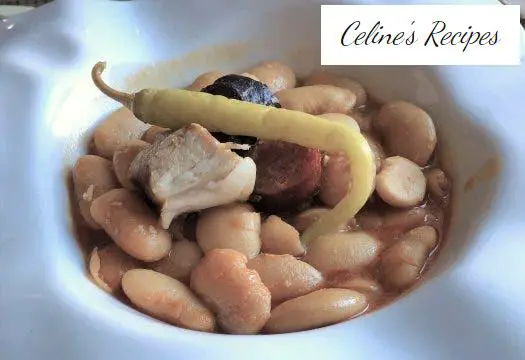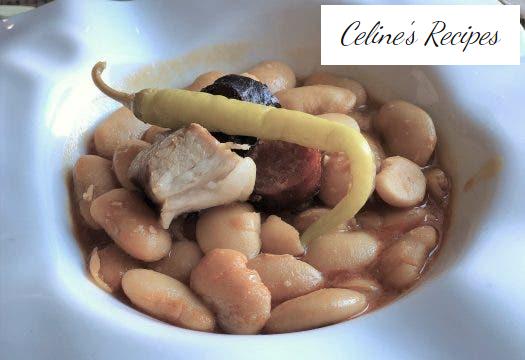
Info.
- Half
- 150 minutes
- For 6 people
- 2.2 € / person
- 335kcal per 100g.
How to make beans from the Farm. Also called beans from La Granja de San Ildefonso, a large white Segovian bean with a great reputation in Spanish cuisine.
Let a stew of those that remove hiccups! Well there we went, to the Farm of San Ildefonso and we ate some beans that would not have raised the dead.
Because there is nothing richer than a few well-cooked beans from La Granja, with permission from the Asturian bean stew .
The bean with which this dish is prepared is a kind of large size of beans or white beans and nowadays you can find it in any supermarket in your neighborhood, you do not need to go to Segovia to buy this magnificent legume.
Did you know that beans were used as animal feed a long time ago? Yes, the wife of Felipe V, Isabel de Farnesio, had these vegetables planted to feed her pheasants, meat that she was very fond of.
Little by little, the eating habit spread among the rest of the animals and finally it ended up being consumed by humans. Today it is considered a delicious and highly valued dish, and luckily for our pockets, it is quite inexpensive. This recipe is the simplest version of the beans with meatballs that we have on the blog, which would be for a more special occasion.
A recipe that has no mystery. A highly recommended dish to remove the cold that I really like to serve when guests come home. Who are encouraged?
Before starting with the stew. The beans and their cooking
- The night before cooking the beans we put them to soak, with plenty of water and a pinch of bicarbonate (the tip of a teaspoon of coffee as a measure). The beans must be of quality and the same year, if possible.
- The next day we strain the water where we have soaked the beans and transfer them to a large pot.
- Add cold water to cover the beans and two more fingers. Add the bay leaf and let the beans boil over high heat. We will leave a glass of cold water next to it, to scare the beans in the middle of cooking
- It is very similar to the preparation of Asturian bean stew, with cold water to lower the temperature at the beginning of cooking and prevent the interior of the legume from swelling quickly. This way we prevent them from breaking and with the skin floating in the stew.
- Important, as in all spoon stews with beans we should not use wooden spoons or similar to stir, as we will break them.
- When we see that the beans are boiling at the top, it is when we add the glass of more cold water and let them boil again.
- Also, when the beans begin to cook, it is convenient to froth to eliminate that foam that are usually impurities formed in the cooking.
- At this point we incorporate the black pudding, the ear, the snout (the ear and snout desalted), the sausages and the blood sausage to cook. We cover the pot and let the beans cook over low heat for approximately 3 hours.
- During the three hours of cooking, we will check that the beans always have enough liquid to prevent them from drying out and clinging to the bottom of the casserole. If necessary we would add a little cold water.
Final presentation of the farm beans
- While the beans are cooking we are going to chop half the onion. In a frying pan add a little olive oil and add the onion.
- We let it be done little by little until it is tender and lightly golden. At that time we add a little sweet paprika (about half a tablespoon of coffee). To fatten we can add about 5 cooked beans or a teaspoon of corn flour (the latter optional ingredient).
- We stir it well and pour two tablespoons of the bean stock. We let it cook for a whole minute.
- After time we add the sofrito to the pot. Chop the garlic cloves and put them in the mortar together with a little parsley and salt.
- We add 4 or 5 tender beans to the mortar and prepare a mash. We will have a paste that we add to the pot. We shake the pot with our hands and add salt to taste and if necessary, a little more cold water.
- We let it continue cooking everything until the bean is tender (in my case it has been three hours).
- Once ready, remove the pot from the heat. We remove the meat and the sausages, chop them and return to incorporate them into the pot to serve it all together. I like that each one is served what they want and with a piparra on top, that spicy and crunchy touch I love.
These beans are well suited to rest, the rest from one day to another works wonders in this stew. Settles flavors and fattens the broth, yummy.
If you still do not have it clear, I leave you a step by step in photos of this recipe for beans from the Farm . Do not miss any detail and they will be perfect.
Tips for some yummy beans
- As in most stews, we must keep an eye on the pot at all times, to prevent it from running low on liquid and thus preventing the legume from catching on the bottom of the pot.
- Many think that cooking vegetables is to eat as a family, but you would be surprised at the success that my La Granja beans have as a main dish at any event. If you still think of a 2 plate, I recommend that you accompany it with a second soft plate, for example a grilled or baked fish.
- These Jews do not have much complication as you have read previously. Like so many legume stews throughout the Peninsula, they consist of having some magnificent legumes on hand and cooking them with taste and chup chup.
- Can they be made in a pressure cooker? Yes, of course, although the result will not be the same. If you don’t have time you can choose this way of stewing. As in the bean stew in an express pot, the beans must be cooked with the times indicated in the instructions for your pressure cooker, for vegetables.
- In my case, the moment the two rings of the pot appear, we lower the heat to 4 (of 10 points) and cook for 20 minutes. We turn off the heat and leave the pressure cooker until the rings go down again and we can open it. Then we continue with the recipe as I explain in part 2.






